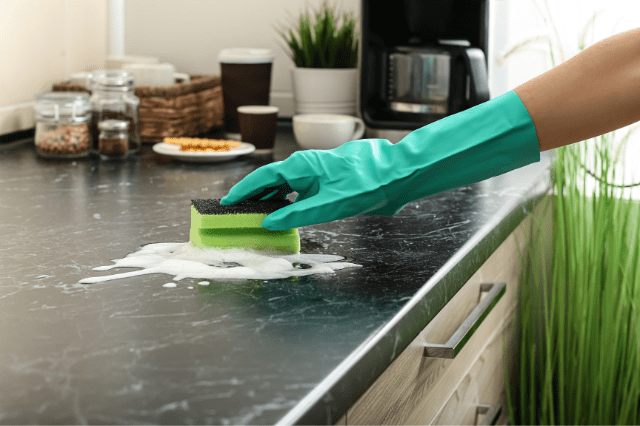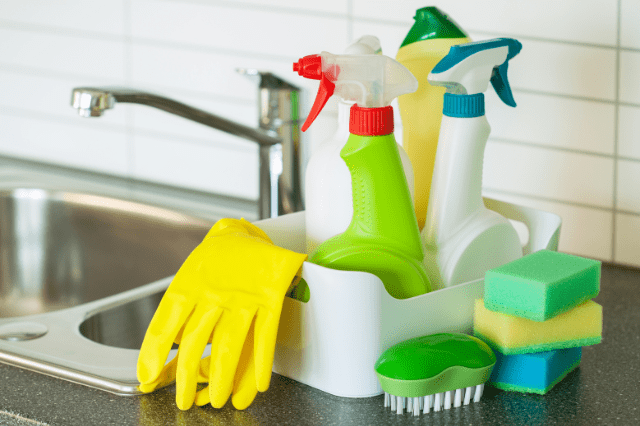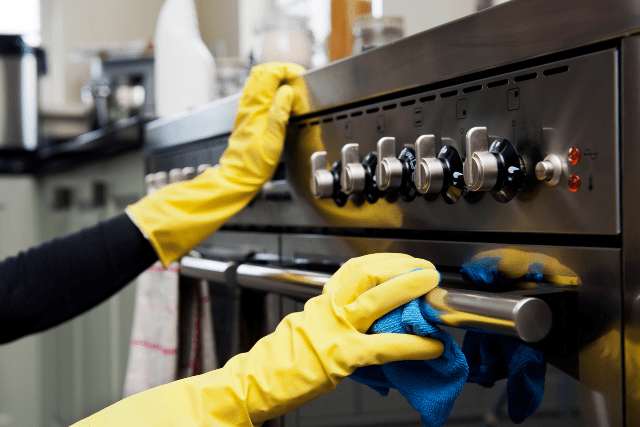Kitchen gloves have become a regular part of our lives, used daily for cleaning the kitchen, washing the dishes, and even grocery shopping. Kitchen gloves protect your hands from hot pots and pans. Kitchen gloves are a must for any home cook. It’s easy to get started with kitchen gloves; choose your favourite colour, then add one to your cart 🙂
What are kitchen gloves for?
In the kitchen, kitchen gloves protect your hands from harsh chemicals, hot surfaces, and rough surfaces. They are often made of cotton or latex and come in various sizes to fit different hands.
Some people like to use kitchen gloves when preparing food because it helps them avoid getting food on their hands and prevents them from coming into contact with hazardous ingredients. Other people use kitchen gloves when cleaning, as they can handle tougher cleaning tasks without coming into contact with harmful chemicals.
No matter what your reasons for using kitchen gloves are, choosing the right type and size for your hands is important. Some people prefer thin gloves, while others prefer thicker gloves. Some gloves have a textured palm, while others do not. Ultimately, the best way to find out if you need to buy kitchen gloves is to try a few and see what fits best.
Types of kitchen gloves
There are three main types of kitchen gloves: disposable, reusable, and hybrid.
Disposable gloves are the cheapest option and are usually thrown away after one use. However, there are some ways to reuse disposable gloves. Here’s how:
- Put them over your hands when cooking: This will help protect your hands from hot oil or other cooking ingredients.
- Wipe down surfaces after you cook: Disposable gloves can help you clean up messes quickly and easily.
- Use them to clean up spills: If a spill happens while you’re wearing disposable gloves, take them off and wipe them clean with a cloth or paper towel.
- Treat minor cuts and scrapes: If you get a cut or scrape while wearing disposable gloves, put some pain relief cream or antibiotic ointment on it and replace the gloves.
Reusable gloves are better than disposable gloves because they can be washed and reused often. However, reusable gloves are unreliable because they can get wet and be difficult to dry.
Hybrid gloves are a great option if you’re looking for disposable and reusable gloves with some of the best features. They’re affordable, easy to clean, and durable. However, they may not last as long as either type of glove.

Choosing the right gloves for you
The best kitchen gloves protect from heat, moisture, and bacteria. Some factors to consider when selecting a pair of gloves include:
The cooking you’ll be doing
Frying eggs is messy, and they can easily contain oil and hot grease. Ensure you get a pair of cooking gloves specifically designed for this task. They should have a thick insulation layer so your hands stay warm and dry while cooking. Boiling water doesn’t require as much dexterity as frying eggs. You don’t need as thick of a glove as you do for frying eggs because boiling water contains no oils or grease.
The materials used in the construction
Leather is a traditional option but can be expensive and difficult to find. Synthetic materials are becoming more popular because they are often cheaper and last longer.
Consider the climate where you will be using them. Winter gloves usually have thicker layers of fabric to keep your hands warm, while summer gloves have thin layers that allow your skin to breathe.
If you will be handling raw meat or cooking on open flames, you will need cook gloves rather than leather ones.
The level of protection
Are you seeking the perfect kitchen gloves to protect your hands from burns and other injuries? Thin gloves are less effective than thick gloves at protecting your hands from burns or other injuries. Thick gloves will cover most of your hands, while thin gloves only cover a small area near your palms. Thicker gloves will also provide more protection against cuts and scrapes.
If you plan to handle raw meat or poultry, thick gloves are essential. Thin gloves will not protect your hands properly against bacteria and other harmful substances that may be present in these foods. Furthermore, if food gets caught in the gaps between the fingers of thin gloves, it can cause severe burns.

Benefits of using kitchen gloves
kitchen gloves are a must-have for anyone who spends time in the kitchen. Not only do they protect your hands from bacteria and reduce the risk of foodborne illness, but they can also make many tasks in the kitchen easier.
Here are some of the best gloves for kitchen use and their benefits:
Waterproof gloves: Keep your hands dry and protected from harsh chemicals with these waterproof gloves. They’re made of a durable, puncture-resistant material that’s perfect for cleaning or other messy tasks.
Anti-bacterial gloves: These gloves are treated with an anti-bacterial agent that helps prevent the spread of germs. They’re perfect for use in food preparation or healthcare settings. If you often work with raw meat or poultry, gloves that don’t let bacteria grow are a good choice. They offer good protection against both Gram-positive and Gram-negative bacteria. However, they may not be appropriate if you have allergies to certain types of latex.
Heat-resistant gloves: These gloves protect your hands from hot surfaces. They’re made of a heat-resistant material that can withstand temperatures up to 500 degrees Fahrenheit.
Heavy-duty cooking gloves: These gloves offer good protection from heat and flame, as well as from acids and other chemicals. They’re not as effective against bacteria but are still a good option if you’re worried about food poisoning.
When should you replace kitchen gloves?
- Replacing kitchen gloves every two weeks is ideal, but if they last longer than that, that’s great, too!
- Always keep a pack of new gloves on hand in case of an unexpected spillage or dirty job.
- If the gloves start to feel stiff and uncomfortable, it’s time to retire them and get some new ones.
It’s also important to ensure your hands are clean before wearing new gloves – using the correct kitchen cleaning product will help avoid any bacteria build-up. Finally, don’t forget to dry your hands thoroughly after washing them – this will prevent the formation of bacteria again!
Tips for storing and using kitchen gloves
When it comes to kitchen safety, using gloves is a must. There are many different types and styles of gloves, so it’s important to find the right ones for your hands.

Here are some tips for storing and using kitchen gloves:
- Store gloves in a cool, dry place.
- If possible, wash your hands before working with food. If you can’t wash your hands, use antibacterial soap and water to cleanse thoroughly.
- Place gloves on your hands when preparing food. Make sure they’re fully stretched out so that they fit snugly.
- Keep a box of disposable gloves on hand for quick use when needed.
How to put on kitchen gloves: tips for beginners
If you’re like most people, you probably reach for a dish towel to clean up after cooking. But before you start scrubbing, put on some kitchen gloves. Gloves help protect your hands from bacteria and other contaminants while cooking. Here are tips for putting on kitchen gloves:
- Make sure the gloves fit well. Wearing too tight gloves will not protect your hands and may cause pain. Try on several pairs of gloves until you find ones that fit comfortably and snugly.
- Wet your hands thoroughly before putting on the gloves. This will help the Gloves adhere better to your skin and prevent them from slipping off during cooking.
- Fit the gloves over each hand individually, ensuring they cover all of your fingers except the thumb (or any other exposed skin).
Kitchen glove safety: be safe and know the risks
Kitchen gloves are often worn to protect hands from bacteria and other contaminants, but their use also comes with potential risks. Here are some tips to help keep your kitchen safe and healthy:
- Wash your hands often, especially before you cook. Hand-sanitizing products are available in most kitchens.
- When handling raw meat, poultry or seafood, use separate gloves for handling the food and washing your hands. Wearing gloves will minimize the spread of food-borne illnesses.
- Avoid touching your face or eyes while cooking. Eighty per cent of foodborne illnesses are caused by contact with saliva or mucus from the mouth or nose.
- Keep utensils and surfaces clean when preparing food. Dirty pots and pans can spread bacteria to prepared foods.
- Do not put your bare hand into a boiling pot of water or the dishwasher.
Summary and Conclusion
Whenever you’re cooking, it’s important to wear kitchen gloves. Not only will they protect your hands from burns, but they also make cleanup a breeze. Many different types of gloves are available, so find the right ones for the job.
When choosing gloves, pay attention to the type of food you’ll be cooking and the ingredients you’ll use. For example, some gloves are for handling hot liquids, and others are for handling raw foods. Avoid using polyester or cotton gloves because they can release chemicals when heated up. Finally, always wash your hands after cooking to prevent food-borne illnesses.







